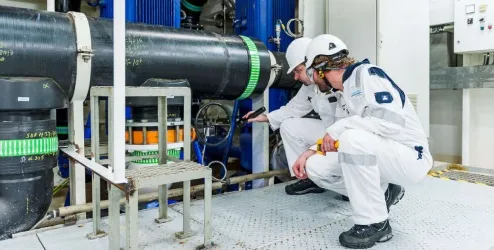The updated MEPC.340(77) 2021 Guidelines for Exhaust Gas Cleaning Systems was adopted in November 2021, and shipowners and manufacturers operating or designing EGCSs (exhaust gas cleaning systems) will need to meet some modified requirements. A summary of the most relevant changes is presented in this statutory news.
Relevant for design offices, shipyards, suppliers, owners/managers and flag states.
The new guideline applies to all EGCS installations which are delivered to vessels or are significantly modified on or after 1 June 2022.
For EGCS installations with a documented contractual delivery date prior to 1 June 2022, but where delivery was delayed due to the pandemic situation, for instance, the MEPC.259(68) guideline may still be applied. Below are some highlights from the updated MEPC.340(77):
Phenanthrene equivalent
The terminology “Phenanthrene equivalent” has properly been defined and should now allow for a level playing field. The definition can be found in Table 3 of the guideline.
Scheme A
It has now been agreed that EGCSs following Scheme A approval need to perform daily SO2/CO2 emission checks as a vital parameter to monitor system compliance.
Documents – OMM and ETM
The Onboard Monitoring Manual (OMM) should now also include the means by which ongoing compliance would temporarily be indicated in case of failure of a single monitoring device (8.2.8). Also, guidance should be given on which indicators can be used to identify a malfunction of the EGCS (8.2.10). Under Scheme B, where operation of the EGCS is required to demonstrate the functionality of the monitoring system, a description of the operational condition(s) needed for their verification during the initial survey now needs to be included in the OMM (8.4). If properly done, this description may replace the need for the additional submission of a MARPOL survey test plan.
The EGCS Technical Manual (ETM) will need to be extended by a clear procedure on how to produce reports that indicate non-compliant conditions or temporarily ongoing compliance as per 8.2.8 (4.2.2.1.9, 5.6.1.7).
Data recording and compliance reporting
Following the new guidelines, the data recording and reporting tool – in addition to required measurement values – now also needs to record and report the applicable limit values for all operational and emission-related parameters. To be able to report applicable emission ratio (ER) limit values, the data processing tool needs to be able to identify whether the vessel is sailing within or outside Emission Control Areas (ECA). For parameter limits which are allowed to be exceeded by an aggregated period, the logging tool should be capable of automatically evaluating and sufficiently reporting failures in meeting these criteria.
Discharge monitoring
Unlike as stated in the MEPC.259(68) guideline, separate fixed discharge limit values have been introduced for process water being discharged from any kind of temporary storage, such as holding or zero-discharge tanks. However, stated limit values (pH = 6.5, PAH = 50 µg/L, turbidity = 25 FNU) only apply for direct discharge to the sea. Water from holding tanks can still be discharged together with process water during open-loop operation, provided the respective discharge limits are met.
The requirements for the sampling and reporting of nitrate analysis results have been eased a bit with the new revision. It is now acceptable to report nitrate concentrations gathered from similar installations instead of always performing individual water sampling and analysis. Nitrate discharge data can now also be presented as the difference of inlet and outlet concentrations.
Finally, a special focus needs to be put on the changes made to the minimum recording frequency requirement for monitoring washwater discharged to sea. While MEPC.259(68) required a sampling and recording frequency of not less than 0.0035 Hz (every 4.76 min), it has now been increased to 0.011 Hz (every 90 sec). This may be a challenge for all monitoring units which are installed in a bypass pipe of the main discharge lines.
Supportive documents
Attached to the guideline you will now find the following documents that aim to assist you when preparing for EGCS approval:
- Standard seawater titration curve, which can be used to support calculation-based methodologies to demonstrate compliance with pH criteria (Appendix 4)
- Analyzer information templates specified in a table format (Appendix 5).
Recommendations
DNV advises its customers to take an active role in the EGCS business and to finalize their preparation to meet the upcoming challenges clarified in the MEPC.340(77) guideline by:
- Reviewing document templates for additionally required information to be included
- Updating data processing and reporting tools to meet the new requirements
- Revising specifications of the water monitoring units, reflecting the increased sampling frequency as well as the implementation of the new definition of phenanthrene equivalent
- Critically reviewing the piping arrangements directing discharge from temporarily stored process water and evaluating the potential need for additional water monitoring systems.
References
- MEPC.259(68) – (adopted on 15 May 2015) – 2015 Guidelines for Exhaust Gas Cleaning Systems
- MEPC.340(77) – (adopted on 26 November 2021) – 2021 Guidelines for Exhaust Gas Cleaning Systems
- MEPC.1/Circ.883/Rev.1 – (adopted on 15 December 2021) – Guidance on indication of ongoing compliance in the case of the failure of a single monitoring instrument, and recommended actions to take if the exhaust gas cleaning system (EGCS) fails to meet the provisions of the EGCS guidelines.
Contact
- For customers:
DATE - Direct Access to Technical Experts via My Services on Veracity. - Otherwise:
Use our office locator to find the nearest DNV office.
